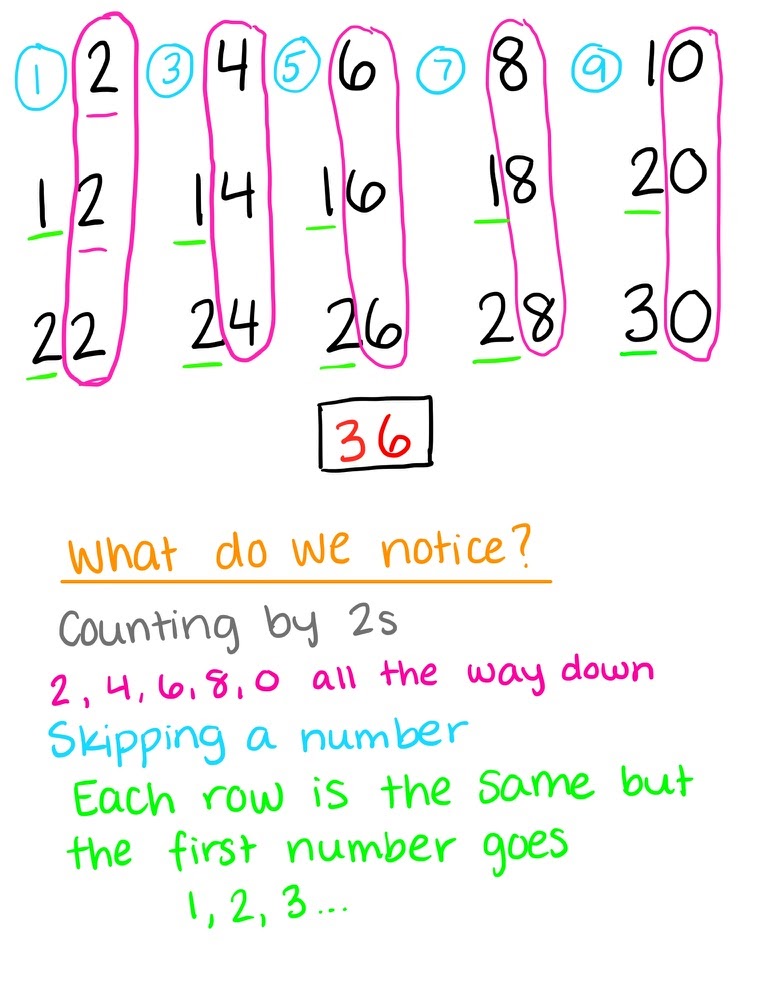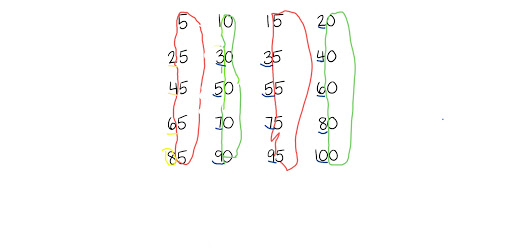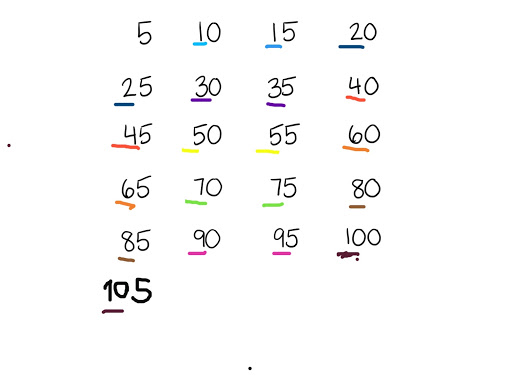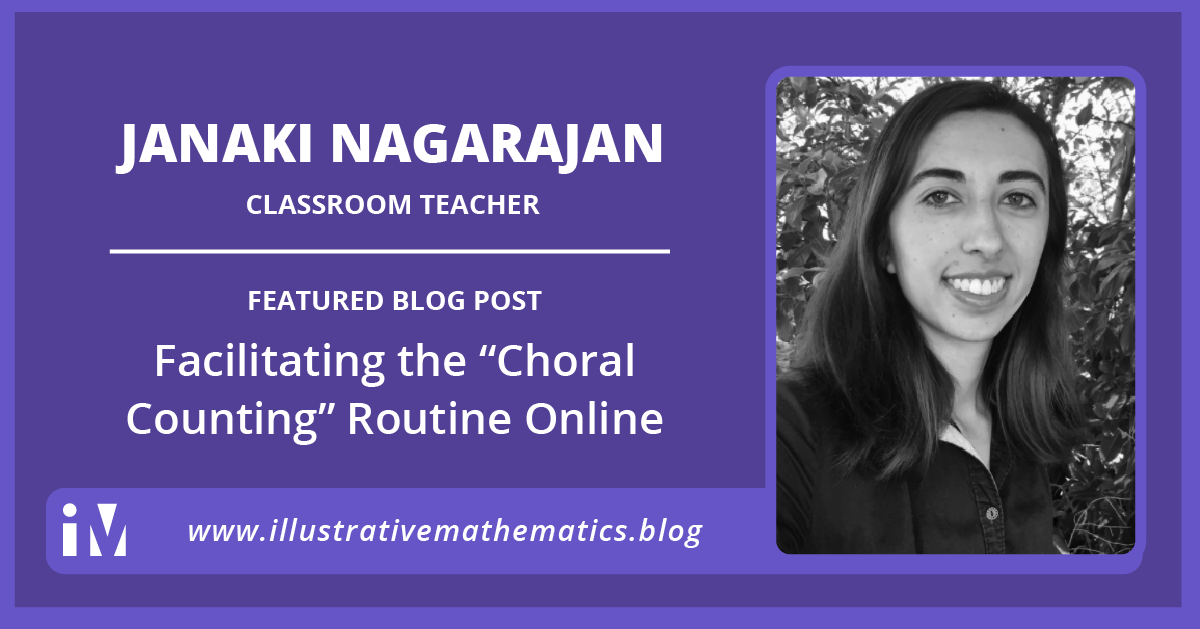by Janaki Nagarajan
How can we best do mathematics together in an online environment?
When school suddenly shifted online last spring, I found myself overwhelmed by the learning curve for new technologies—for both myself and my students. I knew that I wanted to maintain a space centered on students’ collective thinking and understanding.
It frustrated me that I felt pressure to lean on the “bells and whistles” in digital platforms, which often distracted more than supported my mission.
This frustration led me to make a list of how I could use technology consistently and only to enhance students’ experience rather than create it. As I planned and created math lessons this spring, I asked myself questions to affirm my values:
- How can I see and hear children’s thinking, and how can I use what I observe to adjust practice?
- What opportunities does distance learning afford me to learn more about student thinking than may normally be possible due to various in-school limitations?
- How can I use technology to enhance student agency?
- How can I use technology to let students see each other’s thinking?
Instructional routines are an important part of the math classroom. Using instructional routines regularly creates a space where the whole class engages collectively—fostering discourse and developing number sense.
Some instructional routines are easier than others to facilitate in a virtual space. A routine that presents a unique challenge is choral counting, because much of it is collective: collectively counting, collectively thinking out loud. In both synchronous and asynchronous instruction, we face barriers with what technology will allow us to do collectively.
Choral Counting
Choral Counting engages children together around ideas of place value, patterns, relative size and quantity, and much more. It’s an incredibly powerful and important routine, but I struggled to imagine how it would work in an online environment.
In the classroom, choral counting looks and sounds like students counting together with “one class voice,” the teacher writing the numbers as they count and pausing at certain points, both predetermined and spontaneously selected. Students are turning and talking, sharing patterns or connections they notice, and making predictions about what numbers will and won’t be in the count. They might also think about why certain patterns occur, represent the count with base-ten blocks or make connections to previous counts.
Our First Choral Count Online
Just as I did in the classroom, I started our virtual session on Zoom with the goal for the day: count by 2s, starting at 2. We would then think about the patterns we noticed together. I gave students some independent think time, so that they would feel ready to count the next few numbers, and then unmuted everyone’s microphone. We counted as I wrote each numeral via screen sharing.
We paused a few times when the virtual lag threw our counting off, or when kids were in different places, or when students seemed unsure of what might come next. Following our count, students had the opportunity to share patterns they noticed as I annotated the count with different colors, just as I would in the classroom.

— Student, explaining why the number 36 should go in the black box
Having all students microphones on at once led to a rather chaotic count—definitely not “one class voice”. Current technologies that we use for synchronous lessons don’t really allow for a lot of people to talk at once because of background noises and internet speeds.
An adjustment, in this case, might be to pick one or two students who can be unmuted and lead the count together while the teacher records (students can take turns being the lead counters). All other students would be muted but counting along at home. The student leaders do not have to be (and it’s more interesting if they’re not) “perfect” at reciting the count—if they get stuck or are unsure, it’s a great opportunity to pause and discuss ideas about the count as a class.
It’s also important to consider how to replicate the collective discussion that happens in physical classrooms while choral counting—the turn-and-talks, the back-and-forth about a pattern or noticing—this cannot be mirrored exactly in a virtual setting. While my students raised their hand to indicate they had an idea to share, to get kids talking to each other, teachers could use small group breakout rooms where students discuss what they notice together and bring their ideas back to the whole class.
Teachers could also set a norm of 2–3 kids unmuting themselves at a time to share an idea and having that back-and-forth dialogue with a couple other kids—the way adult virtual meetings often go when the floor is opened for people to comment or respond to each other.
Extending Choral Counting Asynchronously
It wasn’t enough to think about how to recreate the routine of choral counting in a virtual classroom. I thought about the opportunities distance learning affords me to learn more about student thinking than what we’re able to do in a classroom. Often in classroom-based choral counts, I am able to hear from one student at a time. This might be one student speaking during a whole class discussion, or one student I am listening to during a “turn and talk” pairing, but my ability to listen is limited by space and time. In the virtual world, I can learn about every single student’s thinking.
As a follow up to our class count, students were given a pre-written 5s count and asked to count out loud and annotate any patterns they noticed in Seesaw. Seesaw allows students to draw directly on the template provided (in this case the 5s count) while audio recording. Students used different colors to mean different patterns—through this activity, students had agency.
One student noticed a pattern in the columns—the ones place was either 5s or 0s, and the tens place was counting by 2s. Another student noticed a pattern in the tens place—1, 1, 2, 2, 3, 3…etc. Even if students did not feel ownership over terminology like “ones place” or “tens place,” they still had an entry point. Technology allowed them to annotate exactly what they meant when they said “I circled that because it’s counting by 2s”.


Students finished the task by finding (and representing) items in their space that came in groups of 2 or 5. They are learning to see that mathematics is everywhere, in the world around them, and not just something done at school or in a physical classroom.
Interacting With One Another’s Ideas
It’s incredibly important for students to see and interact with each other’s thinking. There are many ways to use technology to do this. Our class used the Seesaw “blog” where student submissions would be published and any student or family in the class could see what others had done. Many tech tools offer something similar, and some may allow students to type or record audio/video in response to their classmate’s submission. Another idea is to use one of the student-annotated counts as a follow-up during the next live meeting, and have students think about what patterns that student might have noticed from looking at their annotations.
Ultimately, we should use technology and digital tools in a way that positions students—discussing and thinking together—at the center of everything we do. Using the choral counting routine in the virtual classroom allows all students to engage in meaningful and joyful mathematics.
Next Steps
If you will be teaching virtually, think about how you would start the routine of choral counting in a physical classroom. How can you adapt it to fit in a virtual space? Use questions from the list to help guide your planning.
Think about how your students can engage in choral counting both synchronously and asynchronously. What will that look like? How will they engage with each other’s thinking?
References
Franke, M. L., Kazemi, E., & Turrou, A. C. (2018). Choral counting & counting collections: Transforming the preK-5 math classroom. Portland, NH: Stenhouse.
